



NAB Rural Commodities Wrap – December 2011
Agricultural commodities are weakening as the result of the Euro sovereign debt crisis and rising production prospects, according to Michael Creed, Agribusiness Economist at the National Australia Bank in the Economic Report for December 2011.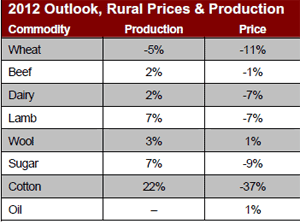
These forecasts represent year-on-year average changes in A$ price and production between 2010-11 and 2011-12 financial years
Prices across the broad commodities complex have fluctuated sharply over the past month and are generally lower than levels seen a month ago. Escalating concerns over European sovereign debt and a more uncertain global economic outlook have overshadowed slightly more positive economic data out of the United States. Market volatility has been rising following a reprieve over the first half of November. Coordinated central bank action and prospects for a new European compact may have helped to restore a degree of calm in financial markets, by way of providing renewed hope for the resolution of sovereign debt problems. However, significant political hurdles remain along with continuing financial instability and fears of a European credit crunch.
As the global growth outlook has become increasingly uncertain, a broad range of commodity prices has generally declined over the past month, although there is considerable variation within the commodities complex. Commodities perceived to have safe haven properties, such as gold, should continue to benefit from market fragility and the prevailing risk-off attitude. In contrast, commodities reliant on industrial production and global trade, such as bulk commodities and base metals, are likely to continue to come under pressure, although the scale of recent falls may provide some upside risk. Oil prices are being pressured by competing drivers, although worries around the global economy appear to be winning out. Nonetheless, geo-political tensions surrounding Iran and a still tight stocks situation in Europe have provided some support to prices.
Agricultural commodities have not been immune from the sell-offs, with prices for almost everything grown having weakened since mid-November. While a weakening global economy is having an impact, there is also a very strong production response hitting agricultural commodity markets. Australia is on track for a massive winter crop while sugar and cotton production has generally responded to high prices seen earlier in the year. In contrast, livestock prices have held up reasonably well, as the structural lags between prices and production are generally longer than for broad-acre crops.
Market volatility will continue to set the tone for commodity prices entering 2012. Markets will remain focussed on European sovereign debt issues, although attention has also been shifting towards emerging economies as scepticism grows over their capacity to weather the global headwinds. This will pose considerable risk for agricultural commodities, where any sign of weakness in the emerging economies will have considerable impacts on demand. This has already been evident in some commodities, where upward revisions to forecasts of stocks levels have come at the expense of weakening demand. With prices already responding to improved production prospects, any weakness in the emerging economies is likely to expose prices to considerable downside risk.
While global prices for agricultural commodities are weaker, conditions within the Australian farm sector remain very strong overall. According to recent ABARES forecasts, the volume of Australian farm production in 2011-12 is forecast to increase four per cent, while export earnings from farm commodities are expected to rise to $34.5 billion in 2011-12, up from $32.4 billion in 2010-11. With record winter and summer crops on the cards, good pasture conditions and ample feed boosting livestock production, the sector remains on the right side of the multi-speed economy. However, some risk is posed by recent rainfall across southern Queensland and New South Wales, which has frustrated the harvest and is raising concerns around crop quality.
Currency Movements

The A$/US$ pulled back below parity again due to the global risk-off attitude brought about by the Euro sovereign debt crisis as well as the impact on weakening commodities prices. Looking into 2012, however, NAB expects the A$/US$ to return to parity after a brief fall to around the mid-90-cents level. It expects to see a trading range of around US¢15 through 2012, roughly similar to 2011, with the extremes being between 0.90 and 1.05. Our strongest view is that the A$/US$ peaked at 1.10 in August this year. The forecast for the A$/US$ is for parity in the second half of 2012 but NAB now forecasts a decline to around 0.95 over the next quarter as global growth slows and the RBA cuts rates again. The Euro-zone muddling through, a soft landing in China and no slashing of official interest rates by the RBA suggests a modest rebound in the A$/US$ from around mid-2012 as worst fears are not realised.
NAB Rural Commodity Index
Prices for rural commodities continued to ease back in November, with the NAB Rural Commodity Index falling 1.3 per cent in A$ terms in November while the US$ index was up 1.1 per cent in the month. Driving the monthly result were price falls in sugar, wheat, cotton, lamb, dairy and barley. Beef prices, on the other hand, were up in the month. Looking ahead, agricultural commodity markets are facing considerable headwinds over the near term. The run up in commodity prices in 2010-11 has well and truly passed as the balance sheets of most commodities are reverting to more comfortable positions. This is taking place against a back-drop of a weakening outlook for the global economy and heightened volatility in financial markets. As such, agricultural commodity prices are exposed to significant downside risk over the near term. Offsetting this to some degree, will be continued strength in livestock prices over the coming months, still buoyed by dwindling global flock and herd numbers.
NAB Farm Input Indices
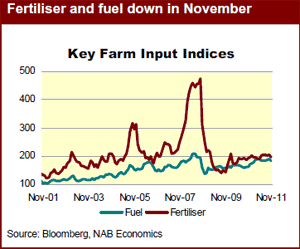
Fertiliser prices weakened in November, with the NAB Weighted Fertiliser Index falling 4.7 per cent in month average terms. Driving the fall in November were price falls across the board, with diammonium phosphate leading the charge (down 5.5 per cent) while natural gas prices were down 4.3 per cent. A strengthening month average A$ saw urea prices rise to a more modest extent. Given the extent of price falls for a number of key agricultural commodities in recent weeks, we anticipate continued weakness in fertiliser prices. A degree of caution is likely to persist in fertiliser markets while prices for agricultural commodities are weakening and the Euro zone debt crisis continues to throw up financial market volatility. Reflecting the decline in fertiliser prices, the fuel price index also declined in November, down 2.8 per cent.
NAB Weighted Feed Grains Price
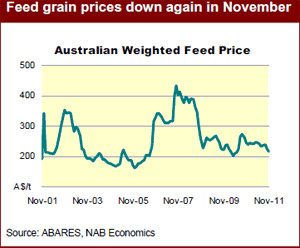
Feed grain prices pulled back sharply for a second consecutive month in November, with the NAB Weighted Feed Grains Price falling 4.1 per cent on October levels. Driving the monthly movement were falls across the board, with prices of sorghum (down 9.1 per cent) and barley (down 6.4 per cent) feeling the brunt of the price falls. Price falls for maize (down 2.3 per cent), feed wheat (down 2.2 per cent) and triticale (down 0.9 per cent) were modest while oats prices remained unchanged. At $217.40 per tonne, the NAB Weighted Feed Grains Price now sits at its lowest level since June 2010, prior to the run up in global grains prices. With a massive winter crop being harvested, huge carry-over stocks of feed grains from last season and the supply squeeze in the global coarse grains being eased, prices for feed grains are likely to continue to fall. This is likely to be exacerbated by recent rainfall frustrating the east coast harvest and potentially adding to already abundant stocks of feed grains.
Key Commodity Prices
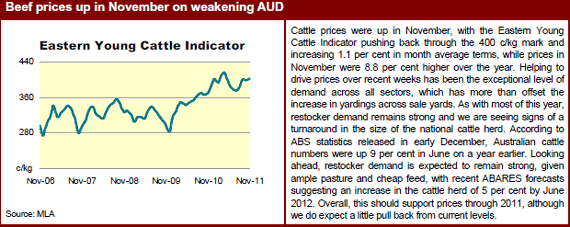
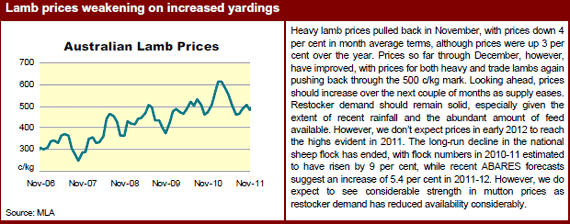

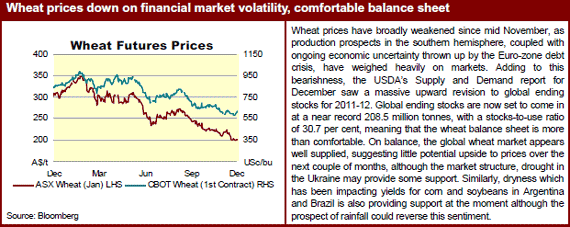
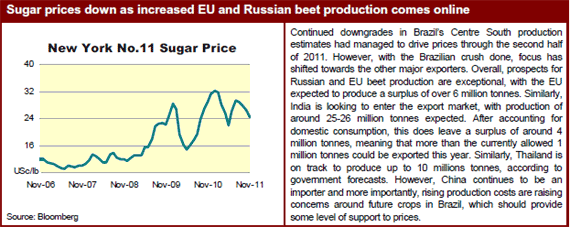
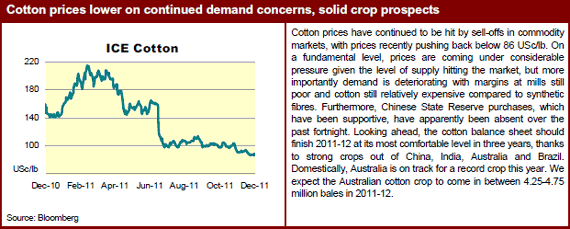
Further Reading
| - | You can view the full report by clicking here. |
December 2011








